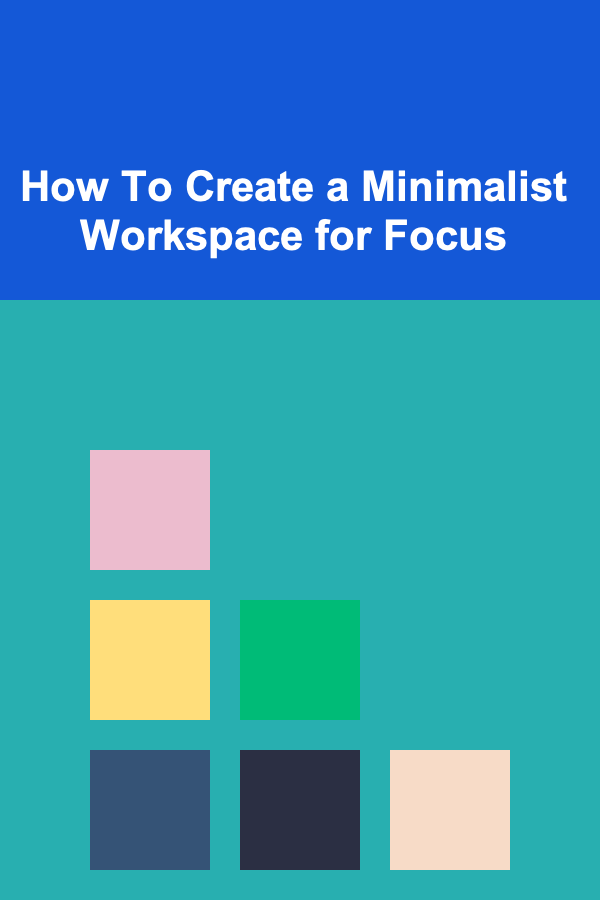
How To Create a Minimalist Workspace for Focus
ebook include PDF & Audio bundle (Micro Guide)
$12.99$7.99
Limited Time Offer! Order within the next:

In a world full of distractions, finding a workspace that fosters focus is invaluable. A minimalist workspace is not just about aesthetic appeal; it's a tool for productivity and mental clarity. By eliminating unnecessary clutter and simplifying your environment, you can create a space that encourages concentration, creativity, and efficiency. This article will explore how to create a minimalist workspace that maximizes focus, offering practical advice and steps you can follow.
What Is a Minimalist Workspace?
A minimalist workspace is a setup that removes excess and focuses only on the essentials. The minimalist approach isn't about owning less for the sake of it but instead optimizing your environment to support the task at hand. In the context of work, this means having only the items you need to complete your work effectively, and eliminating distractions and unnecessary objects that could divert your attention.
At its core, minimalism is about simplicity, intentionality, and clarity. It's about creating a harmonious space that allows you to focus and feel calm, rather than overwhelmed or scattered. A minimalist workspace is a reflection of the productivity and mental focus you wish to cultivate.
The Benefits of a Minimalist Workspace
Before diving into the specifics of creating a minimalist workspace, it's worth understanding why this approach works. The benefits of a minimalist workspace go beyond just aesthetics. Here are some of the most significant advantages:
1. Reduced Distractions
When your workspace is cluttered, your brain can easily become overwhelmed by all the items surrounding you. Every object, piece of paper, or pile of books competes for your attention, making it harder to stay focused. A minimalist workspace removes these distractions, allowing your mind to concentrate solely on the task at hand.
2. Improved Mental Clarity
Clutter isn't just a physical burden; it's a psychological one. A clean and organized workspace can help clear mental clutter, fostering a sense of calm and reducing stress. This clarity allows you to think more effectively and work more efficiently.
3. Increased Productivity
By reducing distractions and fostering clarity, a minimalist workspace can significantly improve productivity. When everything you need is within reach and there is less visual noise, you can focus on your work without unnecessary interruptions. This leads to faster completion of tasks and a greater sense of accomplishment.
4. Enhanced Creativity
A minimalist workspace also nurtures creativity. When you're not overwhelmed by distractions, your mind is free to think more clearly and generate new ideas. The simplicity of the environment encourages you to focus on creative problem-solving without being bogged down by extraneous elements.
5. Better Organization
Minimalism promotes better organization, making it easier to locate and access the items you need. An organized space allows you to work more efficiently, as everything has a designated place. The more organized your workspace, the less time you'll waste searching for things.
6. Reduced Stress
A clutter-free environment has been shown to lower cortisol levels (the stress hormone) and help you feel more relaxed. Minimalism allows you to cultivate a space that supports both physical and mental well-being, helping to reduce stress and improve your overall work experience.
Key Principles of a Minimalist Workspace
Creating a minimalist workspace is more than just clearing off your desk. It requires a deliberate approach, focusing on the following core principles:
1. Keep It Simple
Minimalism is about stripping away anything that is unnecessary. This applies not only to the items on your desk but also to the design and layout of your workspace. Choose simple furniture, neutral colors, and clean lines. Avoid overly decorative or distracting elements, and instead, focus on functionality and purpose.
2. Prioritize Functionality
Every item in your workspace should serve a specific purpose. If it doesn't help you complete your work or support your focus, it doesn't belong in the space. This includes the furniture you choose, the tools you use, and even the way you organize your desk. Functionality should always come first.
3. Optimize for Comfort
A minimalist workspace doesn't mean sacrificing comfort. Comfort is crucial for productivity, so make sure your chair is ergonomically designed, your desk is the right height, and your lighting is conducive to working for long periods. Comfort promotes focus and ensures that you can work efficiently without physical discomfort causing distractions.
4. Maintain Cleanliness
A minimalist workspace should be kept clean and tidy at all times. Cleanliness is integral to the minimalist ethos because it supports mental clarity and reduces stress. Ensure that your desk is free from unnecessary items and that everything has a designated place when not in use.
5. Use Natural Elements
Incorporating natural elements like plants, wood, or natural light can bring warmth and balance to your minimalist workspace. These elements promote well-being and contribute to a calming atmosphere, enhancing focus and creativity. However, it's important to keep these additions minimal and purposeful.
6. Limit Digital Distractions
Technology can be a major source of distraction, especially if you have a phone or multiple devices within easy reach. Consider limiting digital distractions by turning off notifications, using website blockers, and setting boundaries around your digital devices. This will help maintain your focus and prevent unnecessary interruptions during work.
Steps to Create a Minimalist Workspace for Focus
1. Declutter Your Workspace
The first step in creating a minimalist workspace is decluttering. Start by removing all the items from your desk and workspace. Go through each item and decide whether it is necessary for your work. Be ruthless in your evaluation---if it doesn't add value to your work, get rid of it. Common items to consider removing include:
- Extra paper or notes
- Unused office supplies
- Decorative items or knick-knacks
- Outdated files and documents
- Random objects that don't serve a clear purpose
Once you've removed the unnecessary items, take some time to clean the space thoroughly. Wipe down your desk, shelves, and any other surfaces. This will create a fresh, clean environment to work in.
2. Organize Your Essentials
Now that you've decluttered, it's time to organize the items you've decided to keep. Keep only the essentials within arm's reach, and make sure each item has a designated space. Use storage solutions like trays, baskets, or drawer organizers to keep things tidy. Here's how to approach the organization of different elements in your workspace:
- Desk: Keep your desk as clear as possible. Only keep the tools you use most frequently, such as a computer, notebook, or pen. Store everything else out of sight.
- Books: If you have books that you refer to regularly, keep them in a small bookshelf or a drawer. Limit the number of books on your desk.
- Office Supplies: Keep office supplies such as pens, paper, and paperclips in small, neatly organized containers. Avoid having too many supplies that you don't use daily.
3. Invest in Quality Furniture
Your desk and chair are the foundation of your workspace, so it's worth investing in high-quality, minimalist furniture. Choose a desk that suits your needs but is simple in design. A clean, modern desk without too many drawers or embellishments will help maintain the minimalist aesthetic. Your chair should be comfortable and supportive, as sitting for long hours can take a toll on your body. Opt for an ergonomic chair that promotes good posture.
4. Control Your Lighting
Lighting is crucial in any workspace, and a minimalist workspace is no exception. Natural light is ideal, as it helps reduce eye strain and boosts productivity. If possible, position your desk near a window. If natural light isn't an option, invest in quality artificial lighting. A desk lamp with adjustable brightness or a floor lamp can help you control the lighting based on your preferences. Avoid harsh fluorescent lighting, as it can cause discomfort and disrupt focus.
5. Use Color Wisely
Color plays a significant role in your workspace environment. In a minimalist workspace, it's best to use neutral, calming colors like white, beige, gray, or light wood tones. These colors promote focus and reduce visual clutter. If you want to introduce a pop of color, do so sparingly. A single vibrant item, like a plant or a piece of artwork, can provide a refreshing contrast without overwhelming the space.
6. Limit Distractions from Technology
If your work requires digital tools, it's essential to minimize distractions from technology. Here are a few strategies to stay focused:
- Turn off notifications: Disable email and social media notifications on your phone and computer. This will prevent you from constantly checking for updates and help you stay focused.
- Use apps to block distracting websites: Tools like Freedom, Cold Turkey, or StayFocusd can block distracting websites during work hours, allowing you to concentrate on what matters.
- Keep devices out of sight: If your phone or tablet isn't essential for your work, place it out of reach to avoid the temptation to check it.
7. Incorporate Minimalist Decor
While your minimalist workspace should prioritize functionality over decoration, you can still introduce simple design elements that inspire creativity and calm. Consider incorporating the following:
- A single plant: Plants like succulents or small indoor trees can bring life to your workspace without cluttering the environment.
- Artwork or a motivational quote: A minimalist painting, poster, or quote that aligns with your values can add personality to your workspace while keeping distractions at bay.
- Clean lines and geometric shapes: Avoid overly decorative or ornate furniture. Stick to clean, simple designs that align with the minimalist aesthetic.
8. Maintain Regularly
Minimalism is an ongoing practice. To ensure your workspace remains clutter-free and conducive to focus, establish a routine for regular cleaning and organization. At the end of each day, take five to ten minutes to tidy up your desk and put away any items that you no longer need. Keeping the space organized will help you start each day with a clear, focused mindset.
Conclusion
Creating a minimalist workspace for focus isn't about creating a sterile or overly simplistic environment---it's about crafting a space that supports your productivity and well-being. By focusing on the essentials, eliminating distractions, and designing your workspace with purpose, you can create an environment that fosters concentration, creativity, and mental clarity.
Minimalism isn't a one-time project; it's a mindset that requires ongoing attention and intentionality. As you declutter and organize your workspace, remember that the goal is to create an environment that enables you to perform at your best. Keep it simple, keep it functional, and above all, make it work for you.
Reading More From Our Other Websites
- [Biking 101] Indoor Cycling vs. Outdoor Cycling: Which Is Better for You?
- [Home Party Planning 101] How to Make a Signature Cocktail for Your Event
- [Home Rental Property 101] How to Reduce Turnover Rates in Your Rental Property
- [Home Soundproofing 101] How to Reduce Noise in Your Apartment Without Breaking the Lease
- [Personal Investment 101] Building and Monetizing Deep Learning-Based Tools
- [Organization Tip 101] What Tools Can Help You Track Your Home Maintenance Tasks?
- [Stamp Making Tip 101] Step-by-Step: Building Your Ideal Stamp Making Kit on a Budget
- [Home Holiday Decoration 101] How to Add Bows to Your Holiday Decorations for a Classy and Playful Look
- [Organization Tip 101] How to Organize Your Pantry for Quick Weeknight Dinners
- [Home Security 101] How to Keep Your Home Safe While on Vacation

How to Create a Home Budget for Single Parents
Read More
How to Ensure Your One-Page Website Is Accessible to All Users
Read More
How to Organize a Family Charity Drive for a Good Cause
Read More
How to Style Your Home for the Holidays with a Minimalist Approach
Read More
How to Understand and Use Margin in Investment Trading
Read More
How to Plan a Bike-Themed Weekend Getaway
Read MoreOther Products

How to Create a Home Budget for Single Parents
Read More
How to Ensure Your One-Page Website Is Accessible to All Users
Read More
How to Organize a Family Charity Drive for a Good Cause
Read More
How to Style Your Home for the Holidays with a Minimalist Approach
Read More
How to Understand and Use Margin in Investment Trading
Read More